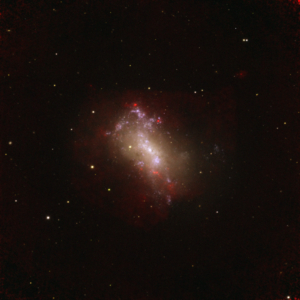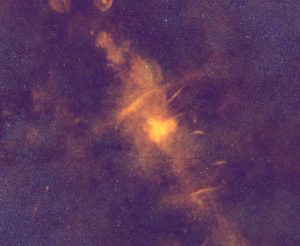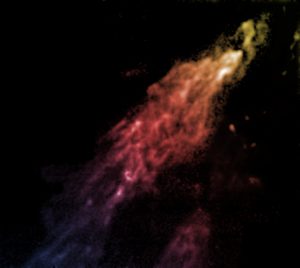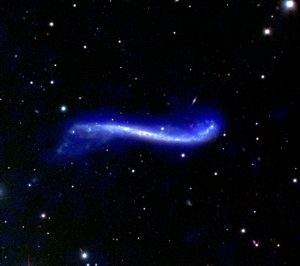Dwarf galaxy UGC 5288 is 16 million light-years from Earth (seen here in pink). The Very Large Array (VLA) found that it is surrounded by a huge disk of hydrogen gas (purple) that has not been involved in the galaxy’s star-formation processes and may be primordial material left over from the galaxy’s formation.


Old, New, and Future Stars in NGC 3596
This gorgeous face-on spiral galaxy is called NGC 3596. This image combines Hydrogen-alpha emission (red), visible light in the R-band (white), and neutral hydrogen 21cm gas emission (blue) from the Very Large Array (VLA). What you see when you combine the invisible waves with visible ones is the enormous shroud of gas surrounding this galaxy. Mature stars twinkle in white, new stars shine their nursery clouds in reds, and the gas for future stars glows in blue.

Making Stars in NGC 4449
Radio imaging with the Very Large Array (VLA) captures newborn massive star clusters as they emerge from their birth material in the galaxy NGC 4449. These “super star clusters” contain tens to hundreds of thousands of stars. The young stars produce hot ionized gas which is detectable at radio wavelengths, shown in red here. An image from the Sloan Digital Sky Survey shows the visible starlight in gold.

The Center of our Milky Way Galaxy
Through the layers of dust that shroud the center of our galaxy from optical telescopes lurks a complex hub of activity. In this wide field Very Large Array (VLA) image, the supermassive black hole in the center of our Galaxy shines brightly in radio waves. Surrounding it are the winds and rivers of material caught in its gravitiational and magnetic wakes. Bubbles of star-formation and supernovas scatter around.

Smith’s Cloud
A false-color image of Smith’s Cloud made with data from the Green Bank Telescope (GBT). It was named after the astronomer who discovered it in 1963, and it contains enough hydrogen to make a million stars like the Sun. Eleven thousand light-years long and 2,500 light-years wide, it is only 8,000 light-years from our Galaxy’s disk. It is careening toward our Galaxy at more than 150 miles per second, aimed to strike the Milky Way’s disk at an angle of about 45 degrees. It’s comet-like shape is due to its interaction with the very outer gases of our Galaxy. It will be stretched apart before it finally hits the denser parts of the Milky Way in 40 million years.

Warped Disk of Galaxy UGC 3697
The “Integral Sign” galaxy, UGC 3697 is an edge-on spiral galaxy with an unusually pronounced warp in both its stellar and gaseous disks. The neutral Hydrogen gas, represented in blue, is overlaid on an optical image of the stars of the galaxy. Unlike in normal spiral galaxies, the brightest concentration of neutral Hydrogen is not found near the center of UGC 3697 but along its western edge, where the Very Large Array (VLA) has detected a bright, extended region of emission. In addition, plumes of gas extend to considerable height above and below the disk of the galaxy.





